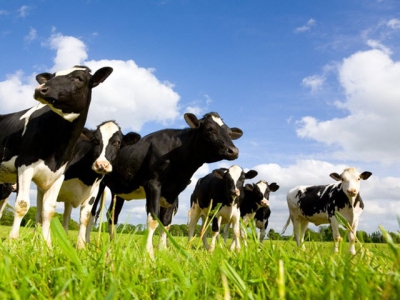US methane reduction project sees $3m investment in domestic seaweed research

Bigelow Laboratory for Ocean Sciences is focusing on developing a feed additive from regional seaweeds to reduce methane production and improve dairy cow health.
The project is being supported by a $3m grant from the Shelby Cullom Davis Charitable Fund, which allows for researchers to collaborate with Wolfe’s Neck Center for Agriculture and the Environment, Colby College, the University of Vermont and the University of New Hampshire.
Research highlighting the potential for seaweed additives generated from the red seaweed Asparagopsis taxiformis to reduce cow’s production of methane sparked interest in exploring native seaweed species present in Maine, said Nichole Price, project lead and senior research scientist at Bigelow.
“We’re always looking for innovative new ways to use new products,” she told FeedNavigator. “There was a discussion among the Maine Seaweed Council members – they wanted to see if any of our seaweed could do that.”
The red seaweed is not native to Maine and is considered an invasive species, she said. “There are a lot of other native species that I would rather see pursued,” she added.
The ability to reduce methane production by cows was of interest to the state’s dairy producers because methane is a greenhouse gas, she said. "Anything we can do to reduce methane is going to help stem climate change."
Analytical tool development
Work leading up to the upcoming, grant-funded research project started with a partnership between Steve Archer and Dave Emerson, research scientists at Bigelow to evaluate the effectiveness of bioactive compounds in different types of seaweed, said Price.
Early steps involved developing “mock communities” or microbe groups established to represent the gut of a cow, she said. “They went to work figuring out not only the best way to identify the concentrations of this particular compound but also [to determine] how active it is in any particular species of algae,” she added.
The pair helped establish experimental assays to provide a quick diagnostic test that could be used to screen multiple species of algae, she said. When that system was established it created a “laboratory benchtop system to look for activity in seaweeds and kind of screen potential seaweed candidates.”
The group also partnered with the University of Vermont (UVM) to enhance the testing process using large fermenters that more closely resemble a live cow, she said.
Grant-funded research
The upcoming grant-funded project starts in December and is intended to run for two years, said Price. The research looks at a blend of seaweeds, rather than a single type, with the intention of creating an additive that provides a health benefit, reduces methane production and can be produced at scale.
“We’ll start by taking several dozen native Maine seaweeds to screen at Bigelow for that bioactive compound, and we’ll also be looking into what’s been published already with respect to their nutritional qualities,” she said. “Then we’ll narrow the candidate list of what species we want to move to the fermenter trials at UVM in the spring, and hopefully we will be able to pick a handful of them that we’ll use in the live animal trials through the summer months.”
The seaweed blends will be tested in organic dairy herds at the University of New Hampshire and the Wolfe’s Neck Center, she added.
“Part of the reason that we want to do it with two different herds, in two different pastures is no two pastures are the same in terms of what combination of grasses they offer,” she said. “So, we want to see how the additive performs in a varied diet.”
The project is primarily focused on work with dairy cattle including grazing herds, she said. However, there is interest in testing additives with beef cattle.
Work on how best to deliver the potential additive at scale is ongoing, said Price. And, researchers are checking for potential negative influences from adding amounts of different seaweeds to cattle diets.
The research group has applied for additional US Department of Agriculture funding to expand the project but will not hear until the spring if the proposal was accepted, she said.
“We also enlisted a macroeconomist from Colby College to help us answer, or at least start to get a handle on, the questions about the price point that the feed industry and dairy and maybe even beef industry … could pay,” said Price. “It has to be affordable and profitable across the board.”
Foray into regenerative agriculture
An additional area of research will be an analysis of the impact of the use of algae or seaweed-based feed ingredient in a grazing dairy herd on soil quality in a regenerative agriculture production system, said Price.
“Seaweed are pretty efficient at pulling nutrients out of seawater,” she said. “We’re really curious, especially for the grazing herds, what kind of recycling or recirculation of those nutrients will come through urine and manure to the soils, [or if] feeding seaweed to a cow has downstream effects on soil health.”
“It’s not just methane suppression, but it could be better nutrient recycling and retention in grazing systems, which is why we’re working with Wolfe’s Neck Center because they’re very focused on regenerative agriculture,” she added.
Related news
 Study explores optimal training for livestock guardian dogs
Study explores optimal training for livestock guardian dogs Bonding pen experiences produce a better livestock guardian dog (LGD). Bonding pens are fenced pastures where dogs bond with the species of their future charges
 Industry wants origin of organic livestock rule finalized
Industry wants origin of organic livestock rule finalized USDA reopens proposed rule on amending origin of livestock requirements for dairy animals.
 Canola oil, nitrate play role in lowering cattle methane output
Canola oil, nitrate play role in lowering cattle methane output Supplementing beef cattle diets with nitrate and canola oil lowered methane yield and daily methane production but it does not alter the flow of microbial